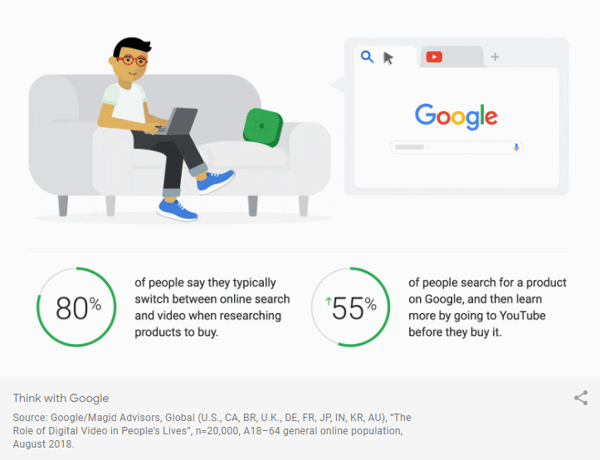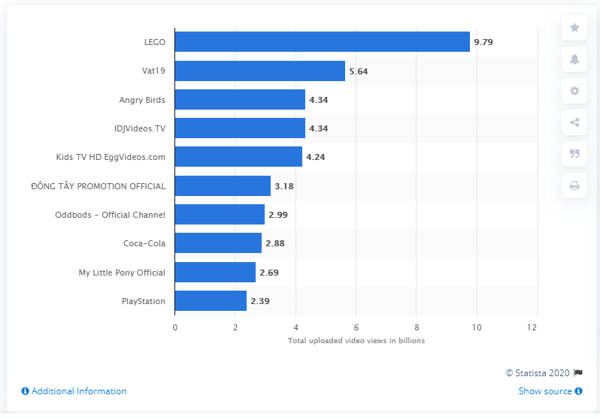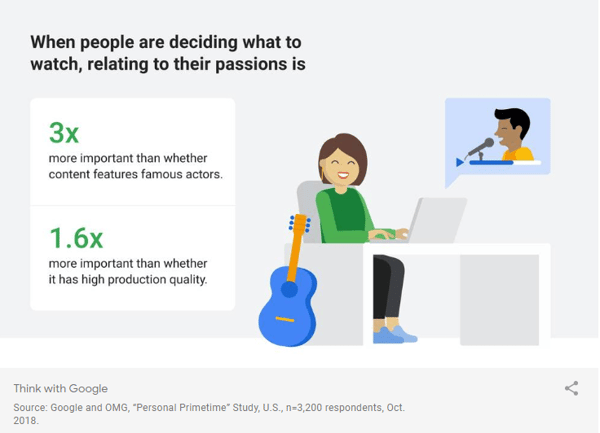.png?width=300&name=BlogHeader-%20How%20to%20Drive%20Customer%20Journeys%20with%20YouTube%20Videos%20(1).png)
How to Drive Customer Journeys with YouTube Videos
Why and how brands can use YouTube videos more strategically
In this post, we explore the role that YouTube is playing in customer journeys, how some global brands are leveraging YouTube via ads and regular programming, and how advertisers and marketers can use YouTube to enhance the relationship between their brand and customers.
YouTube by the Numbers
YouTube is the second most popular social network globally with 2 billion monthly active users (MAUs) behind Facebook’s 2.4 billion MAUs. More importantly, each of these 2 billion people spends an average of 11 minutes and 59 seconds on YouTube every day. Viewers can access YouTube in 80 different languages and it has caption support for more than 165 languages - for context, Facebook is only available in about 111 languages.
73% of U.S. adults use YouTube, versus 69% and 37% of U.S. adults that use Facebook and Instagram respectively. And if your brand is geared towards a younger audience, 81% of 15 to 25-year-olds in the U.S. are on YouTube.
More than 70% of YouTube views happen on mobile devices, an important metric that ties YouTube into the mobile-first approach that advertisers seem to favor. Yet, YouTube is also growing in prominence in the living room. It is the second most preferred platform, after Netflix, from which 18 to 34-year-olds watch video content on TV screens. Last year, its volume of video views on TV screens jumped 39% to more than 250 million hours of watch time.
Understanding the Relationship Between Customer Journeys and YouTube Videos
Google Search is the de-facto homepage of the Internet - it is where almost all customer journeys begin. However, a salient fact that Google’s research uncovered is that users seamlessly transition between Search and YouTube videos during their customer journeys.
80% of people switch between online search and video when researching products to buy. Also, 55% of people search for products on Google and then go to YouTube to learn more about it before they make a final decision.

When people take their customer journeys to YouTube, they typically watch videos for one or a combination of the following reasons: to be educated, helped, entertained, thrilled, reassured, or impressed. For instance, Google reported that the average watch time for YouTube videos for the query “which product to buy” soared by 100% between 2017 and 2018.
The most popular brands driving customer journeys with YouTube videos are proactively leveraging the platform to create content that educates, entertains, informs, helps, reassures, and impresses viewers. The chart below shows the most popular brands on YouTube and their total video views (in billions) as of October 2019.

However, users have the option of skipping TrueView and pre-roll ads after the initial five seconds and there’s a 30% to 80% skip rate for TrueView in-stream video ads depending on how well the ad relates to the actual content.
Creating interesting video content that isn’t outright ads or promotions might be a better way for brands to cultivate an engaged audience on YouTube. When people are choosing videos to watch on YouTube, how well a video resonates with their interests is 3X more important than whether it features famous actors and 1.6X more important than its production quality.

Tips for Driving Customer Journeys with YouTube Videos
- Find a niche revolving around a problem you are solving
Creating a video series on YouTube may be more difficult than creating ads because there are probably thousands of channels created around the same topic, depending how popular the topic is. However, finding a niche around the problems that your products or services solve for users is a better long-term strategy relative to the tactical and short-term nature of promotional videos or “reviews” highlighting your products. Creating a niche will differentiate your brand and help you to build an engaged audience.
For instance, Ikea’s Home Tour series, which consists of more than a hundred videos, provides interior decorators, homeowners, and DIY enthusiasts with simple ideas to achieve the house of their dreams. The series is made up of videos on how to do everything from Family Bedroom Makeovers to Studio Apartment Makeovers and Small Kitchen Ideas.
Organize your channel into sections for different audiences
It’s hard to keep people engaged with the same kind of content over and over. People will eventually lose interest in repetitive content but creating different channel sections is a smart way to appeal to varying interests via the content you are serving. Channel sections allow you to group different videos and playlists that might interest different customer segments or people at different points in their customer journey. YouTube allows each channel to have up to 10 sections.
For instance, you can have a section for demo videos showcasing how your product or service works. Instructional how-to videos can be used to teach your audience foundational knowledge with your product/service as the focal point. Case studies and customer testimonials can show how your products/services have solved specific problems. And live videos can provide exclusive behind-the-scenes insights into how the brand runs.
Lego’s YouTube channel provides an example of how brands can create their YouTube content around sections. The Explained with LEGO Bricks section, for instance, uses Lego Bricks to explain everything from seasons to volcanoes, and genetics. Meanwhile, other sections such as “Hotel of Gloom”, “LEGO Designer Set Review Videos”, and “LEGO Star Wars” are structured around different themes targeted at different audiences.
Leverage new solutions for personalization
One of the key advantages of digital advertising over traditional ads is that brands can A/B test, measure, and personalize content to targeted audiences at scale. Serving personalized video ads will help brands build stronger connections with their audiences.
Škoda Auto delivers a masterclass in personalized video ads with the “Drive of Choice” campaign which combines the viewer’s preferences with Google Audience Signals to serve different variations of the same ad. The team leveraged YouTube Director Mix, a tool that helps you create customized videos at scale by making it possible to swap different elements of a video to tailor content to specific audiences.
Skoda developed eight personas representing different audience pools and they used YouTube Director Mix to create different TrueView ads in which the visual elements and copy were adapted to each persona. Skoda says its Cost per view on the ads dropped by 90% and its View-through rates (VTR) jumped 71%.
Managing Comments on YouTube Videos and Ads
Creating engaging content on YouTube is only the first part of leveraging video to drive customers’ journeys. It is important that brands take intentional action to build healthy communities in the comments feed below their videos because the comment section is usually a thriving microcosm of human interactions.
Highly engaging videos tend to attract lots of comments over time. Gillette’s The Best Men Can Be ad which landed at number 3 on YouTube ads 2019 leaderboard has gathered about 500,000 comments since January 2019. Nike’s Dream Crazier ad which was number 9 on the leaderboard has attracted more than 9,000 comments since February 2019. And the NFL’s 100-Year Game ad which was number 10 on the leaderboard has more than 11,000 comments since February 2019.
Similarly to how people read ratings and reviews on Amazon before buying a product, the comments under YouTube videos can be almost as effective as the actual videos in determining how people respond to organic product videos and ads. When your brand publishes videos and ads on YouTube be rest assured that consumers won’t just take your word for it; they’ll likely read through the accompanying comments before making a final decision.
How then can brands be intentional about building healthy conversations around their videos?
Acknowledge positive comments
If your videos educate, entertain, help, thrill, and impress the audience, some viewers will go beyond hitting the “like” button to drop a comment in the feed. Such positive comments can be short and sweet or they could be detailed and enthusiastic. It is important that your response to positive comments matches the tone of the comment with quick bursts of appreciation or longer replies that highlight the good reviews and show appreciation for your community of fans. Mercedes Benz serves as a good example of a brand with a consistent strategy for acknowledging and responding to positive comments.

Remove harmful comments
Harmful comments such as cyberbullying, violent remarks, and hate speech are potentially damaging to the brand because they create unhealthy associations to the brand and ruin the experience around the video. If the comments under your videos are filled with trolling and hate speech, other users won’t take the time to differentiate between the brand and the user making such posts - they’ll simply move on to the competition or find alternatives. 71% of customers expect brands to manage communication (including comments on YouTube posts) in real-time.
Avoid hiding all negative comments as a blanket rule
You might invest resources into creating a video asset only to discover that it doesn’t quite resonate with your audience or the timing is wrong and it starts attracting negative comments. Brands need to avoid falling into the temptation to blanket hide or delete negative comments or taking extreme measures such as turning off comments. Deleting comments on certain posts often further aggravates the dissatisfied parties and they often go to great lengths to comment on your other videos. Turning off all comments can be misinterpreted as an attack on free speech.
It might be better to have an alert system in place to detect escalating negative sentiment or escalating backlash where the creative is not resonating so that you can respond appropriately in a timely manner.
Respond to customer inquiries and complaints
Some of the comments under your videos will include customer inquiries, feedback, and outright complaints. Brands should proactively develop strategies for managing customer feedback and complaints to avoid last-minute disjointed responses from the customer experience, product, and marketing teams. For instance, you should always respond to complaints publicly, steer the conversation into private channels when necessary, and then follow up publicly to confirm that the issue has been resolved.
In Summary
YouTube videos are gradually becoming a critical part of customer journeys. Between 2016 and 2018, the average watch time on shopping-related videos on YouTube increased by more than 5X. Beyond video ads, brands should proactively create YouTube content that informs, entertains, helps, and educates their target audiences.
The story doesn’t end after you publish a new video. Engaging with the viewers in the comments is equally important to reinforce positive comments while turning around negativity with timely and thoughtful responses.
At BrandBastion we offer a range of engagement management solutions for YouTube. Would you like to know more about how you can manage customer engagement at scale?
